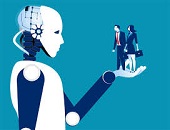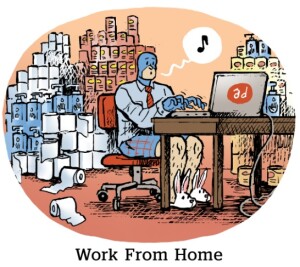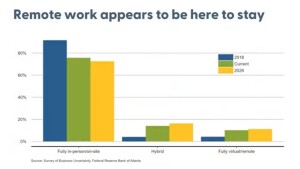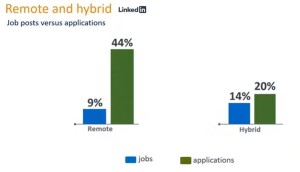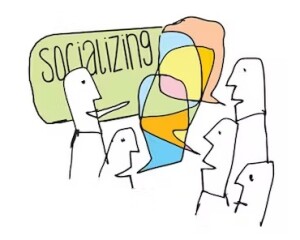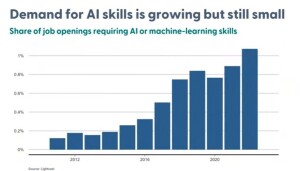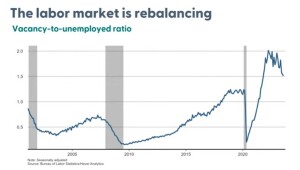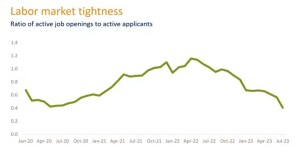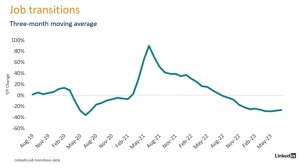Now that the Covid-19 pandemic fears are receding, what is happening to the average workplace—will it become more or less virtual? Will some workers prefer to continue working from home and refuse to commute? As for generative AI—how will that change the future of work?
“There will always be work to do, but it will be different from the work we know now,” said Mary C. Daly, President and CEO of the U.S. Federal Reserve Bank of San Francisco (FRBSF), known informally as “the Fed.” She was the introductory speaker on September 8, 2023, at a presentation outlining the Fed’s thinking on “the future of work.”
Daly described the role of the Fed as “working on the economic data of today and preparing for the economics of tomorrow.” Regarding the two issues exciting greatest interest, the post-pandemic recovery and the use of generative artificial intelligence, she said, “We will see the impact of choices made today having an impact on the workforce of tomorrow.”
“Every technologist tells you ‘AI will change the world.’ We know AI is likely to be disruptive,” she cautioned. The issue of generative AI is a sticking point in two “Hollywood” strikes, for actors and writers. “However, the effect of the pandemic in creating a desire to work from home, or “remote work,” is also changing the work landscape.”
Remote Work vs On-Site vs Hybrid
“Workers clearly see the benefits of remote work, but businesses less so,” said Sylvain Leduc, Executive Vice-President and Director of Research at FRBSF. He showed a graph of the proportion of remote workers five years ago (2018), today (2023), and projected five years hence (2028). From 2018 (dark blue) to 2028 (yellow) the percent of businesses requiring their employees to be fully in-person, on-site will decrease around 10 percent. “Remote is here to stay,” he concluded.
“Workers consistently prefer the option of remote work,” said Karin Kimbrough, Chief Economist at the professional networking site LinkedIn. Her company represents about 950 million members who have summaries of their professional lives online, and about 65 million companies. “We can see what workers are doing when they change roles,” she said. “We also notice when employers put up job postings through LinkedIn.” She noted, “Eight people are hired via LinkedIn every minute.”
A graph of the number of remote-work positions vs. hybrid positions created from LinkedIn data shows the imbalance between desire for remote work compared to what is on offer. Only nine percent of job postings mention “remote work” while 44 percent of applications are looking for “remote work.”
For hybrid work, the percentages are closer, with 14 percent of jobs offered for hybrid workplaces and 20 percent of applications asking for hybrid positions. “This number is not static,” she cautioned.
Mentoring is something required to pass work culture from one generation to another, and “it is very important for new workers,” Leduc said.
Kimbrough said LinkedIn data showed “Gen Z were the first to want to come back—they want to socialize at work, and they will get on-site mentoring. Gen X were willing to come back, too.”
However, Millennials were reluctant to come back to the office, especially those with children who have scheduling needs. “Women preferred remote work more than men,” she said, especially when schools were closed due to the pandemic.
Leduc said that some employers, who want to offer lower wages and/or entice certain workers, now offer remote-work flexibility instead of higher wages. “The Fed is trying to bring inflation down, and we are interested in the impact this job option has on wages.”
Effect of AI on Employment
The Fed surveyed the number of openings requiring AI or machine-learning skills. The percentage was tiny (less than 0.2 percent) ten years ago and has now risen to over 1 percent.
Kimbrough said LinkedIn can see what skills are in demand, e.g., cyber security, “and also that more employers are offering more positions that are remote.”
“We have seen a 21-fold increase in in employers looking for AI skills,” she said (noting that they started from a very tiny number). “More job-seekers are acquiring or showcasing their AI skills.”
What jobs are most at risk for AI displacing human workers?
Kimbrough said that LinkedIn has published a report on AI and jobs. (August 2023). “There are jobs where certain tasks could be performed by AI, such as summarizing notes from a meeting.” Generative AI is “reaching into the professional spaces.” However, she said, “we’re not expecting jobs to be eliminated; mainly they’ll be changed.” AI will also “accelerate the pace of learning certain things.”
Labor Market Rebalancing
Leduc showed a graph of the number of job vacancies vs. the number of workers, the labor market rebalancing.
Kimbrough said that LinkedIn measures the rebalancing of the labor market differently. “We look at the number of job openings on our platform versus the number of people applying for jobs.
“The market is cooling, in a sustained, gradual way.” She noted that industries are cooling at different rates. For example, the demand for teachers is still high. “Companies are hiring more judiciously.”
Leduc agreed; the Fed is seeing less turnover.
“A lower transition rate means people are sheltering in place,” Kimbrough said.
The panel presentation was followed by Q & A. ♠️
Click here to view the panel presentation by Mary Daly, Sylvain Leduc, and Karin Kimbrough.
All graphs are from the FRBSF presentation; permission is pending.
The editorial cartoon is from the website of AdExchanger.
Click here to view the 2023 LinkedIn report, Future of Work Report: AI at Work.

